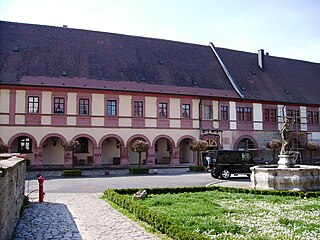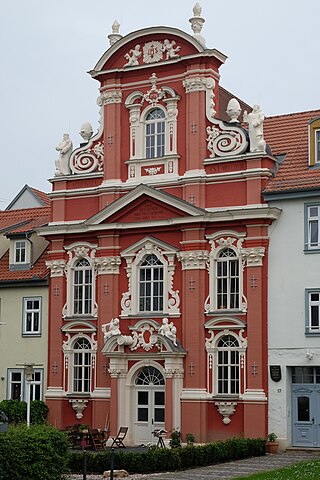
Fritzlar is a small town in the Schwalm-Eder district in northern Hesse, Germany, 160 km (99 mi) north of Frankfurt, with a storied history.

Otto I was Landgrave of Upper Hesse from 1308 and then Landgrave of Lower Hesse from 1311 until his death.

Felsberg is a town in the Schwalm-Eder district about 25 kilometres south of Kassel.

Malsfeld is a municipality in the Schwalm-Eder district in Hesse, Germany, on the river Fulda.

Wolfershausen is one of the sixteen constituent communities that form the town of Felsberg in Schwalm-Eder-Kreis, North Hesse, Germany.

Tückelhausen Charterhouse is a former Carthusian monastery, or charterhouse, in Ochsenfurt in Bavaria, Germany.

Grünau Charterhouse is a former Carthusian monastery, or charterhouse, in Schollbrunn in Bavaria, Germany. It was the first Carthusian monastery in Franconia and in today's Bavaria.

Freiburg Charterhouse is a former Carthusian monastery, or charterhouse, in Freiburg im Breisgau, Baden-Württemberg, Germany.

Cologne Charterhouse was a Carthusian monastery or charterhouse established in the Severinsviertel district, in the present Altstadt-Süd, of Cologne, Germany. Founded in 1334, the monastery developed into the largest charterhouse in Germany until it was forcibly dissolved in 1794 by the invading French Revolutionary troops. The building complex was then neglected until World War II, when it was mostly destroyed. The present building complex is very largely a post-war reconstruction. Since 1928, the Carthusian church, dedicated to Saint Barbara, has belonged to the Protestant congregation of Cologne.

Heiligenburg Castle is a castle on the hill of Heiligenberg in the district of Schwalm-Eder-Kreis, Hesse, Germany.

Eisenach Charterhouse is a former charterhouse, or Carthusian monastery, in Eisenach in Thüringia, Germany, founded in 1378 and suppressed in 1525.

Erfurt Charterhouse is a former charterhouse, or Carthusian monastery, in Erfurt, Thuringia, Germany. It was founded in the 1370s: building works began in 1372 and the monastery was accepted into the Carthusian Order in 1374. Work started on the church in 1375.

Hildesheim Charterhouse is a former Carthusian monastery or charterhouse in Hildesheim in Lower Saxony, Germany.

Vogelsang Charterhouse was a Carthusian monastery or charterhouse near Jülich in the present North Rhine-Westphalia, Germany, founded in 1478 and secularised during the mediatisation of Germany in 1802.

Güterstein Charterhouse was a Carthusian monastery in the Swabian Alb near Bad Urach, Baden-Württemberg, Germany.

Koblenz Charterhouse was a Carthusian monastery, or charterhouse, in Koblenz, Rhineland-Palatinate, Germany. It stood on the Beatusberg, a hill that forms the north-easterly tip of the Hunsrück overlooking the city. The site was first occupied by a Benedictine monastery, the Kloster St. Beatusberg, which was closed in 1315, when the monks were replaced by a community of Augustinian Canons until the Carthusians took over the site in 1331.

Mainz Charterhouse is a former Carthusian monastery, or charterhouse, in Mainz, Rheinland-Pfalz, Germany, demolished in 1790–1792 but still marked by the street-name "Karthaus".



















